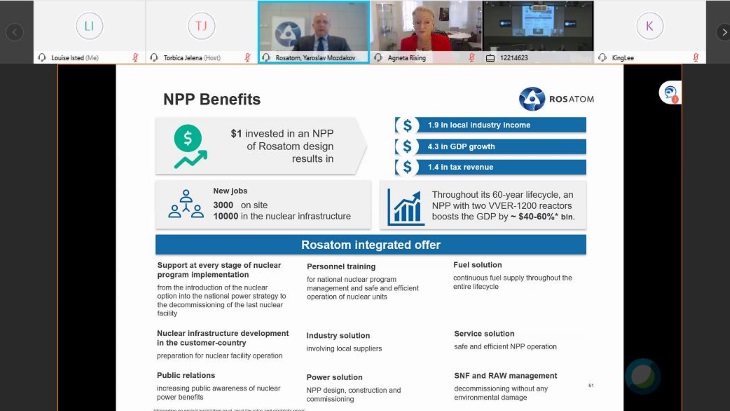"It's quite obvious that Sustainable Development Goal 7, for affordable and clean energy, is our priority," Mozdakov said, "but a nuclear power plant project contributes to at least six of the SDGs and also generates multiple economic effects."
A 2400-megawatt twin-VVER plant provides a clean and stable supply of electricity for at least 60 years, he said, which is enough to power 1.8 million homes on average. It also creates about 3000 direct jobs at the construction site and more than 10,000 others in related sectors.
Rosatom's 10-year portfolio of overseas orders has a value of about USD140 billion and includes, among others, 36 new units at various stages of implementation in 12 countries. Thanks to its serial approach to construction, as many as 15 of its reactor units have been connected to the grid in the last 14 years, eight in Russia and seven abroad - in China, India and Iran.
Around half of Rosatom's 250,000 employees are engaged in its overseas projects, and its global presence in 50 countries "goes beyond" nuclear power plant construction, Mozdakov said.
Its "integrated offer" and build-own-operate model covers the entire fuel cycle and can be tailor-made for each of its customer countries, he said, and nuclear generation goes "well beyond" power supply, to provide economic, budgetary, social and environmental effects.
Rosatom has calculated that every dollar invested in one of its nuclear power plant projects creates USD1.9 for local industry, USD4.3 in GDP growth and USD1.4 in tax revenue. It estimates that, over 60 years, a twin-unit nuclear power plant boosts a nation’s GDP by USD40-60 billion.
At USD20 billion, the Akkuyu nuclear power plant project is the biggest foreign direct investment in Turkey, and will add USD50 billion to that country’s GDP over the plant's lifetime, Mozdakov said. About 13,000 workers will be involved at the peak of the plant’s construction and most of them will be Turkish. At present, about 6000 workers are on-site and 80% of them are Turkish citizens.
Around 40% of the work on the project will go to Turkish companies and so far more than 350 of them have applied to be on the list of suppliers. At the operation stage, Akkuyu NPP with its 4 units will employ 3500 staff, including about 700 qualified Turkish engineers. Some 600 Turkish students will complete higher education courses in nuclear science at Russian universities. Of these, 143 have already graduated and now work on the Akkuyu project. Training programmes have also been launched at Turkish colleges and a training centre for plant operators is to be established on-site.
The Hanhikivi 1 project in Finland involves EUR7 billion of direct investment. The value of works to be provided by Finnish and other EU-based companies is about EUR1.8-2.7 billion. More than 680 companies have applied for work on the project, of which 620 are from Finland. The project is expected to generate EUR45 billion in GDP growth and EUR20 billion in taxation. One job on-site creates 5.5 new jobs off the site, and up to 6.2 new jobs in supporting industries once the plant is in operation, Mozdakov said.
Asked about public acceptance of new nuclear projects, he referred to a 2017 study conducted in Northern Ostrobothnia by the Federation of Finnish Enterprises on the economic effects of the Hanhikivi 1 project. Almost 30% of those surveyed said the project had had a positive effect on their companies’ turnover over the past two years, and over 50% expressed confidence that their companies’ business will continue to grow in line with Finnish utility Fennovoima's nuclear power plant project.
Such a survey proves, Mozdakov said, how local experience of new nuclear projects has a positive impact on public acceptance of nuclear power, not only as a source of reliable and low-carbon electricity, but as a long-term employer and business driver.





_23621.jpg)

_63865.jpg)
_18570.jpg)





